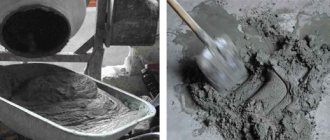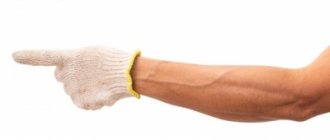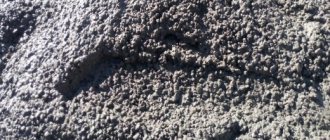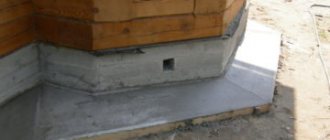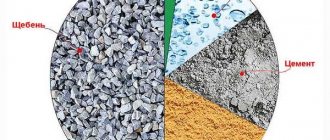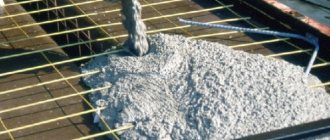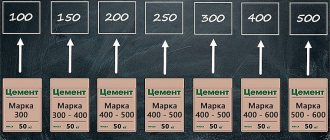Purposes of concreting
Concreting the yard is used for the following purposes:
- creating a flat surface with a solid structure that will not leave traces from large vehicles;
- when concreting the yard of a country house, the formation of dirt and weeds is reduced, and in the winter it is easier to clear it of snow;
- Concreting is used to replace fragile asphalt or expensive tiles;
- The concrete surface in the courtyard of the house allows you to easily install benches, fountains and any other decorative street element.
Return to contents
The nuances of do-it-yourself concreting
Laying concrete has the following nuances:
- For high-quality concrete mortar, sand with large fractions and a small amount of clay admixture is used. To check the quality of the sand, it is poured into a container with water; after shaking, the water should remain clean; if the water becomes cloudy, it means that the sand contains a large amount of clay and silt.
- The concrete coating is strengthened using the ironing method. The method involves dipping a small amount of cement onto hardening concrete and rubbing it into the concrete composition.
- To protect concrete from exposure to sunlight and overheating, it is painted with white paint.
- The use of coatings that contain salts that can absorb moisture from the air will help reduce the level of moisture in concrete mortar.
- To prevent cracks from appearing at the joints, the concrete solution must be poured simultaneously, evenly and in a minimum amount of time.
When using strengthening mixtures that are intended to seal the edges and corners of a site, it is not recommended to pour water on the concrete immediately after it has set. The consequence of such an error will be the detachment of the strengthening mixture.- At the preparatory stage of concreting the yard with your own hands, a slope is provided to drain atmospheric precipitation. To do this, iron pipes are placed on the poured concrete at the moment of hardening and pressed against the concrete. After the solution hardens, the pipes are removed, and the traces from them will serve as a gutter.
Return to contents
Purpose of floor screed with concrete
A screed is a flat substrate for the cladding. The concrete layer performs the following functions:
- Strengthens the base, bears the load from furniture and the inhabitants of the room.
- Levels the surface or creates the planned angle of inclination.
- Provides noise and thermal insulation.
- Serves as a bed for communications, masks them inside the monolith.
The material for the screed is a cement-based mixture prepared in different ways.
In domestic conditions, a cement-sand mortar with the consistency of thick sour cream is often used. It’s easy to prepare it yourself or order M 150 from a concrete plant. The method is labor-intensive, but the technology of concrete floor screed is simple and well studied. Work can be continued a month later, after the concrete solution has been converted into a monolith.
A semi-dry screed is created on a cement-sand base, with the introduction of plasticizers and fiber fiber into the composition. This method of machine-filling a floor screed with concrete requires the use of a compressor pneumatic blower. The mixture is placed tightly and hardens in 12 hours.
Preparatory work
Do-it-yourself concreting begins with preparatory work. First of all, prepare the necessary tools and materials, after which the area is leveled and the top tier of soil, which contains plant roots, is removed. Next, they make a “pillow” of crushed stone and sand. A waterproofing layer in the form of a polyethylene film is laid on the crushed stone. It will not only serve to repel moisture, but will act as a barrier to weed germination. Install formwork along the edges of the site and in areas of future flower beds.
Return to contents
Leveling and preparing the site
Prepared site for concreting.
Work begins with preparing the base; for this, soil with plant roots is removed to a depth of 100 mm. A bedding is made, the thickness of which is from 100 to 200 mm. The “cushion” is made from crushed stone or sand; the use of crushed stone allows you to reduce overall costs. Do not use bedding in places with poorly absorbed soil. After the bedding has been made, crushed stone or sand is compacted and watered. To construct the formwork, wooden boards are driven into the ground. It is important to cover the bedding with a plastic layer and seal it with tape. Polyethylene performs the following functions:
- waterproofing, which is designed to protect concrete from rapid destruction;
- barrier, for grass breaking through the frozen solution;
- shutter, does not allow milk from the cement to leak until the solution sets, which helps to reduce the strength characteristics of concrete.
Return to contents
Cushion creation and compaction
“Cushion” is used to improve the quality characteristics of the concrete base. It is made of crushed stone and sand and laid on the ground in an even layer 100-200 mm thick. If necessary, compact the sand using a channel with a handle. The device is immersed in the solution and tamped alternately up and down. You can also do the following: pour a large amount of water on the sand layer and leave it to settle on its own. The disadvantage of this method is the need for a large volume of water, which increases prices and overall costs. Crushed stone 0.6 cm thick is laid on a layer of sand and also compacted.
Return to contents
Preparation of formwork
Formwork and reinforcement of the yard for pouring concrete.
To ensure that the concrete screed hardens evenly, formwork is constructed that will give it the desired shape. To install the formwork, slate sheets, plastic panels, wooden boards and particle boards are used. Before erecting the formwork, clean the working surface and hammer the bars at equal distances. The panels are connected with self-tapping screws or nails. Then they begin to create wooden clamps, which are used to ensure the reliability of the structure at the moment of pressure of the concrete solution on the walls of the forms.
Return to contents
Recommendations for filling at different times of the year
The filling technology has its own characteristics depending on the region of residence and the time of work.
Pouring walls with concrete mixture and other structures in summer
In summer, at low humidity and high temperature, the solution hardens quickly. A good organization of work and a sufficient number of people are required. If concrete will be delivered, order it from where delivery takes the least time. It is necessary to organize quick unloading - the quality of the product depends on the speed of filling. When preparing by hand, there must be enough workers to ensure the process is continuous.
The solution must contain additives to increase the setting time of cement. The use of water is limited. It can be added to the mixture, from the time of preparation of which no more than 1.5 hours have passed.
In this case, water is used to adjust mobility, but not more than 12 liters per 1 m³. The poured surface, formwork and reinforcement are moistened, but there should not be excess water.
Do not pour directly over the waterproofing - pour 10 cm of sand on it. They don’t delay leveling - they start as soon as the shine of the water on the surface disappears. After finishing, cover with moistened burlap and film. Constantly spray with water until the cement sets completely.
Correct pouring of walls with concrete.
Pouring concrete mortar in the cool season
Weather conditions - low temperatures and humid air - slow down the hardening of the mixture. You will need to wait longer to start grouting the surface. This does not affect the quality, but the speed of work is reduced.
Waterproofing film is used if the project requires it. To quickly set the solution, it is abandoned, especially on surfaces located at an angle. Moisturizing is carried out moderately.
Recommendations for working in the cold season
Builders working in winter are faced with the challenge of preventing concrete from freezing. Negative temperatures place special demands on mixture preparation and pouring. Frost-resistant additives are added to the mortar composition. Warm water is used for preparation, this is especially important if the concrete is delivered by automixer.
Quicklime is added to the solution intended for screeding - it accelerates hardening. Its amount in relation to cement is 0.5-2%. As a result, the material's resistance to destructive stress increases. It occurs when a solution freezes and then thaws. Lime is aggressive towards metal, so plastic mesh is used to reinforce the screed.
Before pouring the structure, make sure that the pillow is not frozen. The work site is heated with special equipment, regardless of what object is being poured and where it is located. The finished product is covered with a film and additionally with heat-insulating material on top. In private construction, straw and sawdust are used in a 10 cm layer.
It is prohibited to pour a solution without a frost-resistant additive at high negative temperatures. This especially applies to pouring a heated floor, over a wooden base or into formwork.
Concreting stages
Concreting the yard consists of the following stages:
- display of beacons;
- reinforcement;
- preparation of concrete solution;
- pouring concrete;
- finishing treatment.
Return to contents
Display of beacons
For placing beacons, the levelness of the construction site is important. This can be ensured even at the stage of laying the “pillow” using a horizontal level. Beacons are placed over the entire area of the working surface for pouring. Thin-sheet profiles and strings, which are connected to each other by stretched stakes or, as they are also called, spiders, can act as a beacon. The spider is designed to guide beacons.
Return to contents
Reinforcement
After installing the beacons, a reinforcement structure is laid between them. It can be made in the form of a wire mesh with a thick diameter. The reinforcement is designed to prevent cracks in the concrete surface.
Return to contents
Preparation of the solution
The most important step in concreting a yard is preparing the concrete solution. There is no need to skimp on its components; purchase only high-quality cement, because the strength of the product directly depends on it. To make the solution you will need the following ingredients:
- one part water;
- one part sand;
- two pieces of crushed stone.
When mixing the components of concrete, it is important to achieve a uniform consistency without the formation of lumps. The solution should have an equally even color.
Return to contents
Pouring concrete
Lay out concrete using a shovel between the previously installed beacons. In this case, the concrete is poured in such a way as to hide the tops of the beacons by a couple of mm. If necessary, excess concrete is removed with a spatula or other smooth tool. To remove excess mortar, fix the strip perpendicular to the beacons and stretch it with a spatula, thus leveling the surface.
Return to contents
Finishing operations
The final stage will be coating the concrete surface with various impregnations. For additional strengthening, a polymer-cement coating is used, which is especially important for edges and corners. Treatment with a polymer-cement composition is carried out immediately after pouring concrete by pouring the prepared dry reinforcing mixture onto the edges of the area. Or after the concrete solution has hardened, but in this case you will need to remove centimeter strips from the surface of the concrete and fill the mixture with diluted water. After the concrete has hardened, the surface is cleaned.
Return to contents
Expansion joints
Concrete mortar is susceptible to climate change, so it is important to provide expansion joints. At the time of high or low temperature conditions, the seams can narrow or expand. Therefore, at the stage of laying concrete, thin slats are laid, after which they are removed once the solution has hardened. Or make gaps after the concrete has hardened.
Return to contents
Applicable forms
To make paving stones or paving slabs, you need to have molds. They are conveniently made of plastic. If large products are required, the formwork is knocked down. Before filling the mold, the wood is moistened with water. Sometimes it is convenient to make the form directly in the ground. To do this, the bottom of the hole is covered with sand, it is moistened and the solution is poured. Then the surface is leveled and covered with film, waiting for the monolith to set. It is convenient to make stencils from different materials. Polystyrene foam is suitable for single use. To remove the finished product from it, the formwork must be broken.
How to care for the surface?
Watering the yard with water to provide moisture to the concrete.
Concrete hardens quickly, however, maximum strength characteristics are achieved after a month. Therefore, it is not recommended to use a surface filled with concrete mortar in the first days. When caring for concrete, maintain an optimal level of humidity, which is especially important in the first few days. The strength of the solution depends on the amount of moisture contained. To provide constant moisture to the concrete surface, it is irrigated with water using a spray bottle. What is especially necessary when laying concrete in the hot season. The air temperature has a direct bearing on the quality of the concrete composition. At high degrees, the strength of the solution is reduced by half. The presence of moisture also affects the subsequent use of concrete bases. When using concrete, it is recommended to water it with a stream of water to avoid drying out during the hot season.
Return to contents
